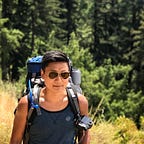The next day in Lhasa, I got to the train station and bought a ticket to 纳木错 (Namtso), the highest lake in the world at some 4700m above sea. The train station is really something… It’s actually a lot nicer than the Lhasa airport but for some dumb reason, they both had to be hundreds of kilometers away from the city. The inside of the train is amazingly nice as well and rivals the Thalis or something. Compartments are pressurized and have oxygen supplies. The ride to 当雄 (Dangxiong), the nearest city, is short and at the platform, only 2 people came off so of course, we, me and a guy from 广东 (Guangdong), the province on top of 香港 (Hong Kong), decided to group up for our trip to the lake.
There’s a little town that’s set up for tourists right next to the lake. Well, it’s not really a town, just a group of container-like temporary houses and the hosts stay there for a few months during the summer and move back out into the city during winter. And not every car can make it there. Most Japanese cars can’t and just stall on the way due to lacking oxygen.
Out here, the feeling’s very different than from Lhasa. The extra 1000m in altitude makes a difference. Climbing mountains here is very time consuming. What would normally take 20 minutes would take an hour. It’s fine when I’m not moving though. Everything is indeed a bit less forgiving than before. First, there’s always the risk of pulmonary edema at this altitude. I can’t take any risk of catching a cold as apparently, it will always end up becoming pneumonia and can be live threatening. There has been several cases of (older) photographers who comes to the lake for its magnificent view just like me and never making it past the first night or passing away as they’re being driven out in ambulances towards the train station. Hilltops are impossible to stay at without more professional clothing. Hard and dry wind made my skin feel very uncomfortable and cool despite having like 4 layers of cloth, half of them being very solid windbreakers elsewhere.
Besides the environment the people of course feels very different as well. They seem…. harsher. Just gotta be more careful about what to say and one thing I’ve observed is absolutely horrible. The parents would “train” their kids to become beggars at young age. On seeing tourists, the parents would send out kids to trail the tourists and follow them for 10 minutes sometimes. Of course, you can’t give them money or 10 other families would mark you as the prey of the day and send their kids (without mentioning that they’re giving a nod to the horrible way of life the kids would be used to) and you can’t get angry at them because they would then send the husbands out to beat you down.
But that doesn’t change the fact that the scene there is absolutely amazing. Despite very harsh winds, the surface appears very calm and is so blue it’s surreal. The entire lake is surrounded by snow peaked mountain ranges. Since the locals don’t actually live there permanently, they have no other income or occupations beside the tourism industry. Half of them are herdsmen only to have steeds for tourists like horses and yaks. The entire hillside’s yaks are there only so tourists can take pictures with them.
As the night sets on the first day, it truly did feel like we’re on our own. The law definitely has no presence here. The only sheriff-ish dude is a normal looking Tibetan dude like everyone else there. There are 2 Han Chinese stores (whose owner, we later found out, lived 2 very hard years before security got a bit better here) in the settlement and at night, as we’re having supper and drinking tea, we closed the windows, dimmed the lights and begun our first rounds of discussion in our temporary communists’ assembly.
